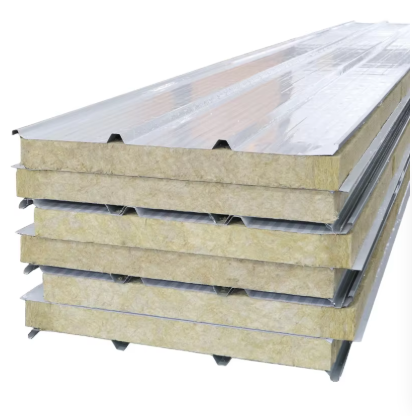Understanding Fire Resistance in Sandwich Panels
How Core Materials Influence Fire Behavior
Understanding how core materials influence fire behavior in sandwich panels is essential for ensuring safety. Commonly used core materials in these panels include Expanded Polystyrene (EPS), Polyisocyanurate (PIR), and mineral wool. Each of these materials reacts differently in fire scenarios. EPS, for example, tends to melt and shrink away from the flame, which can limit flame spread but produce toxic smoke. On the other hand, PIR offers higher thermal resistance, resulting in better containment of fire spread and less toxic emissions. Mineral wool, known for its inert properties, provides excellent fire resistance due to its non-combustible nature.
The thermal properties and density of core materials substantially affect the spread of flames and heat transfer. High-density materials tend to delay heat penetration and flame spread, offering more time for evacuation and fire control. Research has shown that the classification of these materials under fire safety standards varies. For instance, mineral wool is often classified as an A-class material under European standards due to its fire-resistant qualities. Similar studies highlight the prolonged time it takes for high-density PIR panels to ignite compared to EPS, reinforcing the importance of selecting appropriate materials for specific safety needs.
The Role of Fire Retardant Coatings
Fire retardant coatings play a crucial role in enhancing the fire resistance of sandwich panels. These coatings, composed of chemicals like intumescent or ablative compounds, function by creating a protective barrier when exposed to high temperatures. Upon heating, the coatings expand to form a char layer that helps insulate the underlying material, slowing down the spread of flames and reducing heat transfer significantly. This mechanism is vital for providing additional time for evacuation and firefighting efforts.
When evaluating fire retardant coatings, performance metrics such as temperature resistance and flame spread ratings are critical. For instance, a high flame spread rating indicates that the coating effectively limits the rapid advancement of fire, which can be essential in real-world scenarios. Studies conducted by fire safety institutions have demonstrated that the integration of fire retardant coatings can remarkably minimize fire damage in practical applications. For example, coatings that have been tested under conditions mimicking real-world fires show a significant reduction in flame spread and heat release rates, underscoring their importance in fire safety measures.
Core Material Impact on Fire Safety
Rock Wool (Mineral Wool): Class A Fire Resistance
Rock wool, often referred to as mineral wool, is a key player in fire-resistant construction materials, boasting an impressive Class A fire resistance rating. Its structure consists of natural minerals like basalt spun into fibers, making it inherently non-combustible. Known for its ability to withstand extreme temperatures without emitting toxic gases, rock wool is a preferred choice in settings where safety is paramount. A notable example is its role in decreasing the severity of fire incidents, showcasing its effectiveness in protecting structures from catastrophic damage.
PIR Panels: Balancing Insulation and Class B Ratings
Polyisocyanurate (PIR) panels are popular in construction for their exceptional insulation capabilities, despite possessing a Class B fire rating. These panels are designed to balance thermal performance with safety, providing efficient energy conservation without compromising fire resistance. According to research, PIR panels can withstand a high peak heat release rate, nearly 600 kW/m², which speaks to their resilience in fire scenarios. Instances where PIR panels have successfully functioned in fire-sensitive applications illustrate how their design benefits both insulation needs and fire safety standards.
EPS Panels: Risks and Regulatory Challenges
Expanded Polystyrene (EPS) panels are widely used for their cost-effectiveness and insulation properties, but they are often scrutinized for vulnerabilities concerning fire safety. These panels face significant regulatory challenges due to their flammability and difficulties in meeting stringent fire safety standards. In some cases, fires involving EPS have underscored these risks, proving the importance of diligent risk management and compliance with relevant safety regulations. The challenges associated with EPS highlight the need for continual improvement in materials and adherence to fire safety considerations when using sandwich panels.
Fire Safety Standards and Certifications
EN 13501-1 Compliance for Building Materials
EN 13501-1 is a pivotal standard in determining the fire performance of building materials within the European Union. It provides a harmonized classification system that evaluates how products react to fire, considering factors like combustibility, the spread of flame, smoke production, and flaming droplets. For manufacturers, achieving compliance with EN 13501-1 can substantially boost the marketability of sandwich panels, as it assures builders and consumers of their safety credentials. For instance, materials like rock wool with a Class A1 rating under EN 13501-1 are widely accepted for their superior fire resistance, facilitating smoother project approvals and compliance with stringent regulations.
Local vs. International Fire Safety Regulations
Understanding the variances between local and international fire safety regulations is crucial for manufacturers and constructors. While some local regulations might align with global standards like EN 13501-1, others may present different or additional requirements. For instance, in regions like the UK, post-Grenfell regulations have become more stringent, demanding higher fire resistance for construction materials. Conversely, these regulations may vary in stringency in other areas, impacting product selection and sourcing strategies. To navigate these complexities and avoid legal pitfalls, staying informed about the specific regulatory landscape in each region is essential, ensuring both safety and compliance in building projects.
Installation Practices to Enhance Fire Safety
Avoiding Thermal Bridging in Panel Joints
Thermal bridging can significantly impact the fire performance of sandwich panels by creating pathways for heat transfer. These pathways can weaken the overall fire resistance of a structure, making it crucial to address during installation. Best practices to mitigate thermal bridging include using continuous insulation and ensuring airtight panel joints. According to a study in the Building and Environment journal, addressing thermal bridging not only enhances fire safety but also improves energy efficiency by reducing heat loss. By employing effective installation techniques, builders can significantly reduce the risks associated with thermal bridging, thus ensuring both safety and sustainability.
Importance of Firebreaks and Compartmentalization
Firebreaks and compartmentalization are critical elements in fire safety design that help prevent the uncontrolled spread of fire. By breaking a building into sections, firebreaks limit the fire's area of impact, maintaining structural integrity and allowing occupants more time to safely evacuate. Incorporating firebreaks in sandwich panel installations involves the strategic placement of non-combustible barriers, as mandated by various building codes such as the International Building Code (IBC). These guidelines underscore the need for intentional design during construction to enhance fire safety measures. Implementing these strategies ensures that a structure can withstand fire events without massive destruction, aligning with best practices in fire safety management.
Case Studies and Lessons Learned
High-Rise Fires in the UAE: Flammable Cladding Risks
Recent fire incidents in high-rise buildings across the UAE have highlighted significant fire safety concerns, particularly regarding the use of flammable cladding materials. Notable fires, such as those in the Ajman emirate and Dubai's Address Downtown, underscore the role of aluminum composite cladding in rapidly spreading flames across building exteriors. In response to these alarming incidents, the UAE has implemented regulatory changes, including the introduction of fire-retardant cladding requirements for new constructions over 15 meters. However, older constructions were not mandated for retrofitting, leaving many buildings vulnerable. According to a report, prior to these regulatory changes, high-rise fire incidents in the UAE were relatively frequent, with common causes including electrical faults and combustible cladding materials. The regulatory adaptation aims to reduce the frequency and severity of such incidents, ensuring safer building practices.
Korean Regulatory Crisis: Substandard Panels
South Korea faced a regulatory crisis with the proliferation of substandard sandwich panels, which were widely used without proper fire-resistant certifications. This situation arose due to loopholes in the regulatory framework, allowing manufacturers to bypass essential performance testing and quality verifications. As a consequence, a significant percentage of these panels were deemed unsafe, leading to widespread concern over potential fire hazards. In response, the Korean government enforced stricter regulations and suspended certification models that did not meet fire safety standards. A study indicated that before these regulatory tightening, fire-related incidents involving sandwich panels were a growing concern, with inadequate panels contributing to significant fire losses. Post-crisis, rigorous compliance measures have been put in place, aiming to significantly mitigate future risks and improve construction material quality.
FAQ
What are the key factors affecting fire behavior in sandwich panels?
Core materials, fire retardant coatings, and thermal properties are critical factors in influencing fire behavior and resistance in sandwich panels.
How do fire retardant coatings enhance fire resistance?
Fire retardant coatings create a protective char layer that insulates the underlying material, slowing flame spread and reducing heat transfer.
Why are installation practices important for enhancing fire safety?
Proper installation practices, like avoiding thermal bridging and using firebreaks, significantly enhance fire resistance by preventing heat transfer and limiting fire spread.
What are the latest fire safety standards for sandwich panels?
EN 13501-1 and various local regulations ensure that sandwich panels meet essential fire safety criteria by evaluating combustibility and flame spread.

 EN
EN







































